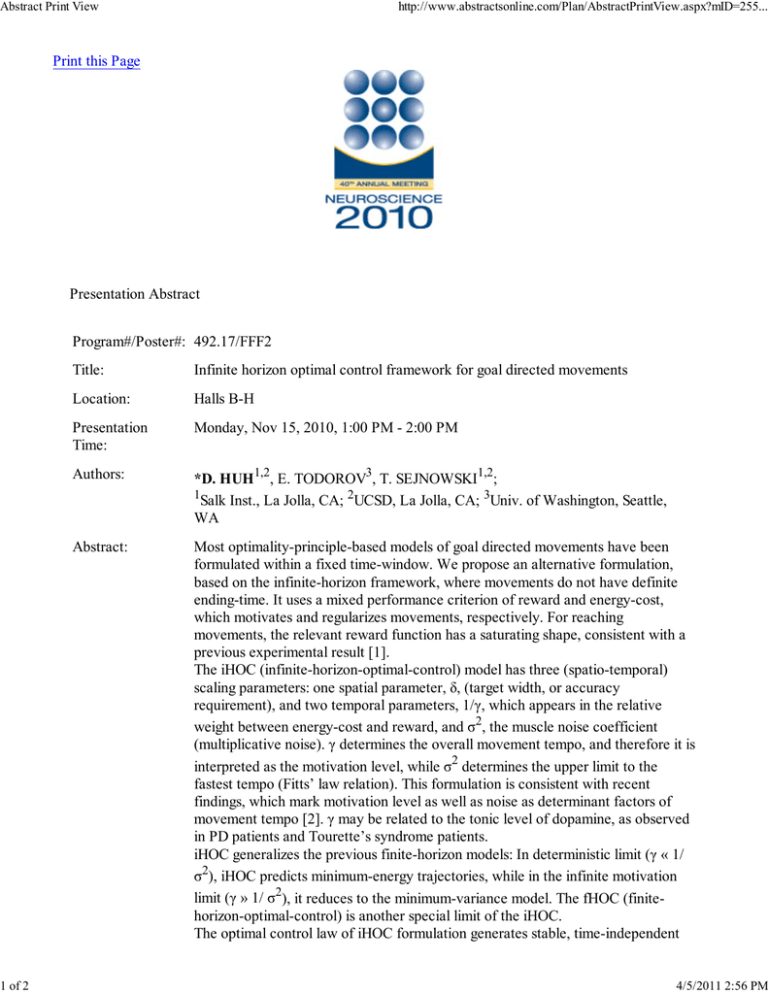
Abstract Print View
1 of 2
http://www.abstractsonline.com/Plan/AbstractPrintView.aspx?mID=255...
Print this Page
Presentation Abstract
Program#/Poster#: 492.17/FFF2
Title:
Infinite horizon optimal control framework for goal directed movements
Location:
Halls B-H
Presentation
Time:
Monday, Nov 15, 2010, 1:00 PM - 2:00 PM
Authors:
*D. HUH1,2, E. TODOROV3, T. SEJNOWSKI1,2;
1
Salk Inst., La Jolla, CA; 2UCSD, La Jolla, CA; 3Univ. of Washington, Seattle,
WA
Abstract:
Most optimality-principle-based models of goal directed movements have been
formulated within a fixed time-window. We propose an alternative formulation,
based on the infinite-horizon framework, where movements do not have definite
ending-time. It uses a mixed performance criterion of reward and energy-cost,
which motivates and regularizes movements, respectively. For reaching
movements, the relevant reward function has a saturating shape, consistent with a
previous experimental result [1].
The iHOC (infinite-horizon-optimal-control) model has three (spatio-temporal)
scaling parameters: one spatial parameter, δ, (target width, or accuracy
requirement), and two temporal parameters, 1/γ, which appears in the relative
weight between energy-cost and reward, and σ2, the muscle noise coefficient
(multiplicative noise). γ determines the overall movement tempo, and therefore it is
interpreted as the motivation level, while σ2 determines the upper limit to the
fastest tempo (Fitts’ law relation). This formulation is consistent with recent
findings, which mark motivation level as well as noise as determinant factors of
movement tempo [2]. γ may be related to the tonic level of dopamine, as observed
in PD patients and Tourette’s syndrome patients.
iHOC generalizes the previous finite-horizon models: In deterministic limit (γ « 1/
σ2), iHOC predicts minimum-energy trajectories, while in the infinite motivation
limit (γ » 1/ σ2), it reduces to the minimum-variance model. The fHOC (finitehorizon-optimal-control) is another special limit of the iHOC.
The optimal control law of iHOC formulation generates stable, time-independent
4/5/2011 2:56 PM
Abstract Print View
2 of 2
http://www.abstractsonline.com/Plan/AbstractPrintView.aspx?mID=255...
dynamics. Moreover, it does not suffer from the critical problems of the fHOC
formulation, such as movement initiation problem and non-zero bias from target
location. These properties make iHOC an ideal framework for implementing
real-time sensori-motor feedback controllers (with recurrent neural networks, for
instance), which will be valuable computational models of the biological motor
control system.
[1] Körding, KP. and Wolpert, D. (2004) The loss function of sensorimotor
learning, Proceedings of the National Academy of Sciences 101:9839-42
[2] Mazzoni P, Hristova A, Krakauer JW. (2007) Why don't we move faster?
Parkinson's disease, movement vigor, and implicit motivation (2007). Journal of
Neuroscience (2007) July; 27(27):7105-16.
Disclosures:
D. Huh, None; E. Todorov, None; T. Sejnowski, None.
Keyword(s):
INFINITE HORIZON
STOCHASTIC OPTIMAL CONTROL
DOPAMINE
Support:
HHMI
[Authors]. [Abstract Title]. Program No. XXX.XX. 2010 Neuroscience Meeting
Planner. San Diego, CA: Society for Neuroscience, 2010. Online.
2010 Copyright by the Society for Neuroscience all rights reserved. Permission to
republish any abstract or part of any abstract in any form must be obtained in
writing by SfN office prior to publication.
4/5/2011 2:56 PM







